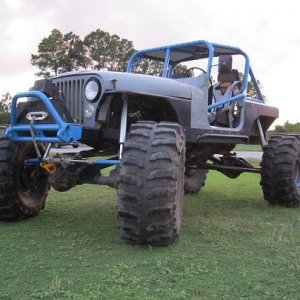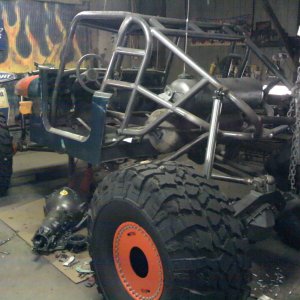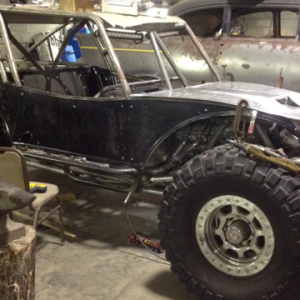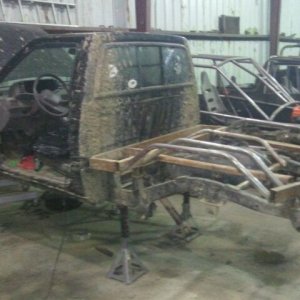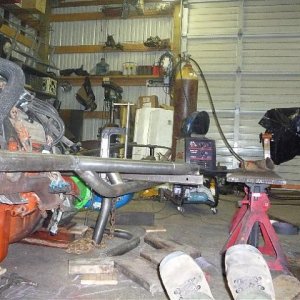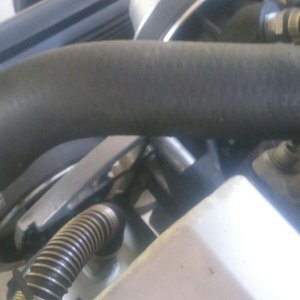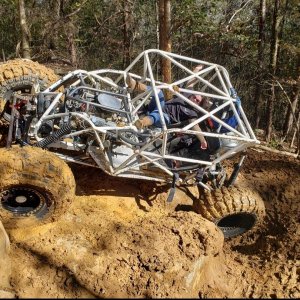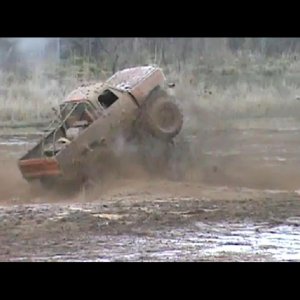I get a lot of PM"s and questions about shock tuning, so I wanted to post up some info. I really enjoy messing with shocks to dial them in and have had all types of shocks apart. I am going to make a few subjects on the different types of shocks, how they work and how to work on them.
Air Shocks
How They Work â€" Air shocks are completely self-contained. They come in 2.0 & 2.5†diameters and various lengths. They are extremely lightweight, most come in under 10lbs per shock. They use Nitrogen (N2) to set ride height and Shock Oil to set spring rate. The more N2 you add the more ride height you get, the more Shock Oil you add the stiffer the spring rate and vice versa. Air shocks have a maximum sprung weight they can carry. Most 2.0’s are between 800 and 1,000lbs max, and 2.5†are 1,200 to 1,500lbs max on average. I would not recommend getting anywhere near these max numbers, as performance will be greatly effected. You see air shocks on many comp rigs because they are lightweight, easy to package and they react/cycle very quickly. Air Bumps or N2 Bumps are the exact same concept as air shocks; they are in fact mini versions of them. They come in the same diameters and smaller lengths. The same applies to bumps in terms of adding oil and N2. Also inside the shock you have valve stacks that control how fast or slow the shock cycles/reacts. You have two separate valve stacks, one is for compression (uptravel) and one is for rebound (down travel). You can adjust them separately to truly fine tune your setup. Valve stacks are simply shims in various thicknesses, and most manufacturers use their own system for naming valves. An example of what Fox uses is 20/40. First number is compression, second is rebound. SAW uses .09/.12 and so on. Most shock manufacturers etch the factory valving specs on the lower shock end. If it is not etched, then they used the stock valving from the factory, so you need to call and find out what it is.
How to Service â€" To add N2 (Ride Height), simply remove all the N2 in the shock at full shock extension. Then add your N2 charge. Regulators on N2 bottles are rarely accurate. I found this out at KOH because we put what we thought was 200 psi in our Bumps, turns out it was only 140psi per the Bilstein Tech’s gauge. So if you have air shocks, invest in a good N2 Tank/Regulator and Fill Gauge. To add Oil (Spring Rate), remove all N2 and unbolt the Schrader Valve. Add oil with a syringe and keep track of how much you add. You can do this on the rig at full shock extension or upright in a vice. If you need to remove all oil and start over, pull the shock and cycle it upside down over a catch can. Most use 5wt Shock Oil, but you can stiffen them up some with 7wt oil. I would stay away from 10wt oil.
Opinion â€" Air Shocks are a great bang for the buck and work great on slow speed crawlers. At high speed they will beat you to death, unless you have 2.5’s which seem to work much better due to the increased oil capacity. I had air shocks on my rig when I got it and it crawled great, but riding around perimeter trails was rough. I was about 600lbs of sprung weight in the front and my 2.0’s hated it and required max oil to keep from bottoming out.
Fox 2.0†Shipped Oil Specs (Ask Vendor for MAX Oil Level)
http://www.polyperformance.com/shop/Fox-2.0-Air-Shock-p-102.html
Fox 2.5†Shipped Oil Specs (Ask Vendor for MAX Oil Level)
http://www.polyperformance.com/shop/FOX-2.5-Air-Shocks-p-182.html
Sway-Away Rebuild Guide (Thanks to JRich)
http://www.swayaway.net/joomla/images/InstallInstructions/9920_2and2-5-AIRSHOCK_R-R.pdf
Air Bump Tech on PBB
http://www.pirate4x4.com/forum/showthread.php?t=680275&highlight=fox+travel+air+bumps&page=2
Air Shock Tech from PBB
http://www.pirate4x4.com/forum/showthread.php?t=655045
N2 Fill Gauge
http://www.polyperformance.com/shop/Nitrogen-Fill-Adapter-p-286.html
Air Shocks
How They Work â€" Air shocks are completely self-contained. They come in 2.0 & 2.5†diameters and various lengths. They are extremely lightweight, most come in under 10lbs per shock. They use Nitrogen (N2) to set ride height and Shock Oil to set spring rate. The more N2 you add the more ride height you get, the more Shock Oil you add the stiffer the spring rate and vice versa. Air shocks have a maximum sprung weight they can carry. Most 2.0’s are between 800 and 1,000lbs max, and 2.5†are 1,200 to 1,500lbs max on average. I would not recommend getting anywhere near these max numbers, as performance will be greatly effected. You see air shocks on many comp rigs because they are lightweight, easy to package and they react/cycle very quickly. Air Bumps or N2 Bumps are the exact same concept as air shocks; they are in fact mini versions of them. They come in the same diameters and smaller lengths. The same applies to bumps in terms of adding oil and N2. Also inside the shock you have valve stacks that control how fast or slow the shock cycles/reacts. You have two separate valve stacks, one is for compression (uptravel) and one is for rebound (down travel). You can adjust them separately to truly fine tune your setup. Valve stacks are simply shims in various thicknesses, and most manufacturers use their own system for naming valves. An example of what Fox uses is 20/40. First number is compression, second is rebound. SAW uses .09/.12 and so on. Most shock manufacturers etch the factory valving specs on the lower shock end. If it is not etched, then they used the stock valving from the factory, so you need to call and find out what it is.
How to Service â€" To add N2 (Ride Height), simply remove all the N2 in the shock at full shock extension. Then add your N2 charge. Regulators on N2 bottles are rarely accurate. I found this out at KOH because we put what we thought was 200 psi in our Bumps, turns out it was only 140psi per the Bilstein Tech’s gauge. So if you have air shocks, invest in a good N2 Tank/Regulator and Fill Gauge. To add Oil (Spring Rate), remove all N2 and unbolt the Schrader Valve. Add oil with a syringe and keep track of how much you add. You can do this on the rig at full shock extension or upright in a vice. If you need to remove all oil and start over, pull the shock and cycle it upside down over a catch can. Most use 5wt Shock Oil, but you can stiffen them up some with 7wt oil. I would stay away from 10wt oil.
Opinion â€" Air Shocks are a great bang for the buck and work great on slow speed crawlers. At high speed they will beat you to death, unless you have 2.5’s which seem to work much better due to the increased oil capacity. I had air shocks on my rig when I got it and it crawled great, but riding around perimeter trails was rough. I was about 600lbs of sprung weight in the front and my 2.0’s hated it and required max oil to keep from bottoming out.
Fox 2.0†Shipped Oil Specs (Ask Vendor for MAX Oil Level)
http://www.polyperformance.com/shop/Fox-2.0-Air-Shock-p-102.html
Fox 2.5†Shipped Oil Specs (Ask Vendor for MAX Oil Level)
http://www.polyperformance.com/shop/FOX-2.5-Air-Shocks-p-182.html
Sway-Away Rebuild Guide (Thanks to JRich)
http://www.swayaway.net/joomla/images/InstallInstructions/9920_2and2-5-AIRSHOCK_R-R.pdf
Air Bump Tech on PBB
http://www.pirate4x4.com/forum/showthread.php?t=680275&highlight=fox+travel+air+bumps&page=2
Air Shock Tech from PBB
http://www.pirate4x4.com/forum/showthread.php?t=655045
N2 Fill Gauge
http://www.polyperformance.com/shop/Nitrogen-Fill-Adapter-p-286.html


 Might be worth asking Darryl what the rates were. I think him and Bryan use stiff rates and always set them up the same, or close to it. Lower rates and less nitrogen can only help.
Might be worth asking Darryl what the rates were. I think him and Bryan use stiff rates and always set them up the same, or close to it. Lower rates and less nitrogen can only help.

